
Hesperoyucca whipplei, the chaparral yucca, our Lord's candle, Spanish bayonet, Quixote yucca or foothill yucca, is a species of flowering plant closely related to, and formerly usually included in, the genus Yucca. It is native to southwest communities of North America.
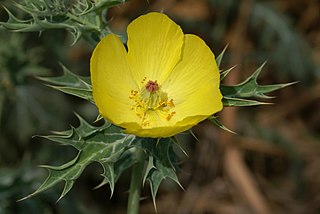
Argemone mexicana is a species of poppy found in Mexico and now widely naturalized in many parts of the world. An extremely hardy pioneer plant, it is tolerant of drought and poor soil, often being the only cover on new road cuttings or verges. It has bright yellow latex. It is poisonous to grazing animals, and it is rarely eaten, but it has been used medicinally by many peoples, including those in its native area, as well as the Natives of the western US, parts of Mexico and many parts of India. In India, during the colorful festival Holika Dahan, adults and children worship by offering flowers, and this species is in its maximum flowering phase during March when the Holi festival is celebrated. It is also referred to as "kateli ka phool" in India.

The Sacramento Mountains are a mountain range in the south-central part of the U.S. state of New Mexico, lying just east of Alamogordo in Otero County. From north to south, the Sacramento Mountains extend for 85 miles (137 km), and from east to west they encompass 42 miles (68 km).
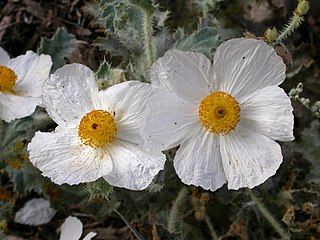
Argemone corymbosa, the Mojave prickly poppy, is a flowering plant in the family Papaveraceae native to the eastern Mojave Desert of the southwestern United States. It especially common around Cima, California and the nearby community of Kelso, California. The plant grows in sandy places and on dry slopes, and is very similar to desert prickly poppy.

Roemeria argemone is a species of flowering plant in the poppy family Papaveraceae. Its common names include long pricklyhead poppy, prickly poppy and pale poppy. Its native range includes parts of Eurasia and North Africa, but it can be found growing wild in parts of North America, where it is an introduced species. It is cultivated as an ornamental plant.

Argemone munita is a species of prickly poppy known by the common names flatbud prickly poppy and chicalote. "Munita" means "armed", in reference to the many long prickles. This flower is native to California, where it is widespread throughout the western part of the state and its eastern deserts, on slopes to 10,000 feet, and along roadsides. Its range also extends into Baja California, Arizona, and Nevada.

Chrysothamnus viscidiflorus is a species of shrub in the family Asteraceae of the Americas known by the common names yellow rabbitbrush and green rabbitbrush.
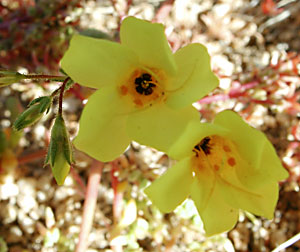
Leptosiphon aureus is a species of flowering plant in the phlox family known by the common name golden linanthus.

Leptosiphon nuttallii is a species of flowering plant in the phlox family known by the common name Nuttall's linanthus.

Oenothera californica, known by the common name California evening primrose, is a species of flowering plant in the evening primrose family.
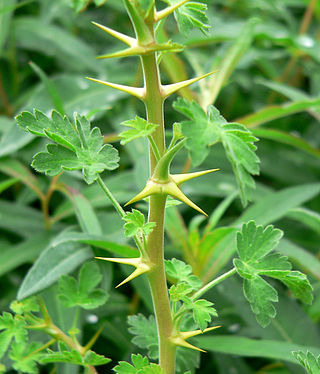
Ribes montigenum is a species of currant known by the common names mountain gooseberry, alpine prickly currant, western prickly gooseberry, and gooseberry currant. It is native to western North America from Washington south to California and east as far as the Rocky Mountains, where it grows in high mountain habitat types in subalpine and alpine climates, such as forests and talus. It is a spreading shrub growing up to 1.5 meters tall, the branching stems covered in prickles and hairs and bearing 1 to 5 sharp spines at intervals.

Hedeoma todsenii is a rare species of flowering plant in the mint family known by the common name Todsen's pennyroyal, or Todsen's false pennyroyal. It is endemic to New Mexico in the United States, where it occurs in the San Andres and Sacramento Mountains. It is federally listed as an endangered species of the United States.

The genus Styrax has an estimated 120 species in eastern Asia, the New World, and the Mediterranean region. Styrax platanifolius is a species of flowering plant in the family Styracaceae known by the common name sycamoreleaf snowbell or "Texas Snowbell". It is native to northeastern Mexico in the states of Coahuila, Nuevo León, and Tamaulipas and the US state of Texas, especially on the Edwards Plateau. Styrax flowering season is estimated to be during the months of April-May. Its fruiting season has been observed to be during July-September. Styrax Platanifolius thrive in more of a subhumid climate.

Dasylirion leiophyllum is a species of flowering plant in the asparagus family known by the common names green sotol, smooth-leaf sotol, and smooth sotol. It is native to North America, where it occurs in Chihuahua and Coahuila in Mexico and New Mexico and western Texas in the United States. It was first collected by Valery Havard in 1880 and was described by William Trelease in 1911.
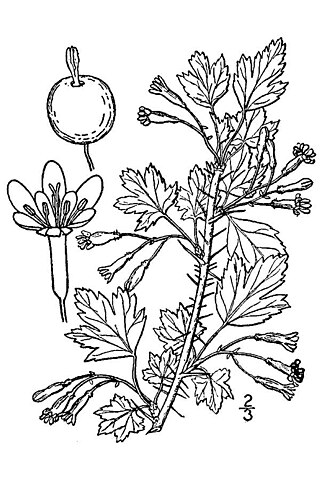
Ribes oxyacanthoides is a species of flowering plant in the gooseberry family known by the common name Canadian gooseberry. Its various subspecies have common names of their own. It is native to North America, where it occurs in Alaska through much of Canada and the western and north-central United States.
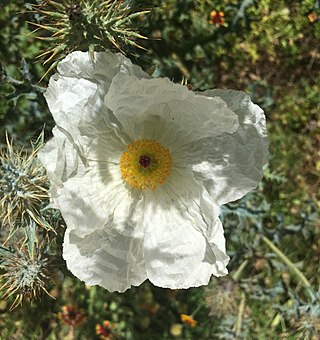
Argemone albiflora, the white prickly poppy, also known as the bluestem prickly poppy or the Texas prickly poppy, is a small erect plant with a decorative white flower with a yellow latex. It is deeply rooted with yellow or red stamens. The plant is known for the sharp prickles on its stem and leaves. The sepals fall off as the flower of this plant grows bigger. It grows in the arid regions of the southern Midwest along roadsides and disturbed pieces of land. Native Americans have long revered this plant for its medicinal and other uses.
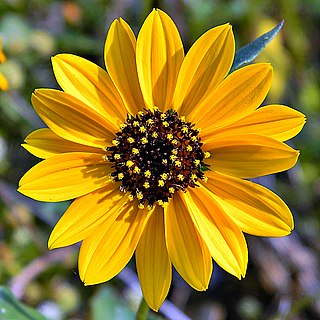
Helianthus debilis is a species of sunflower known by the common names cucumberleaf sunflower, beach sunflower, weak sunflower, and East Coast dune sunflower. It is native to the United States, where it can be found along the Atlantic and Gulf Coasts. It is known elsewhere as an introduced species, such as South Africa, Australia, Taiwan, Slovakia, and Cuba.
Argemone pinnatisecta, known as the Sacramento prickly poppy, is an angiosperm and part of the poppy family. A very thorny looking perennial that grows up to a meter and a half in height. The thorny stems are covered in bluish green serrated leaves with spiky tips. The flower buds are also covered in these sharp thin thorns until they open, between May and August, revealing six white petals up to four centimeters long and nine centimeters wide, and a bright yellow anther with various stamens jetting out. The fruits of plant contain black seeds about two millimeters in diameter.

Argemone polyanthemos, the crested pricklypoppy, also known as bluestem prickly poppy, pricklypoppy, white prickly poppy, annual pricklypoppy, or as thistle poppy is an annual plant with yellow sap and showy white flowers in the poppy family (Papaveraceae).

Argemone ochroleuca is a species of prickly poppy, a flowering plant commonly known as pale Mexican prickly poppy or Mexican poppy. It is native to Mexico and is also an introduced weed in many temperate and tropical regions of the world. It can grow up to 1 m in height and has a sticky yellow sap.



















